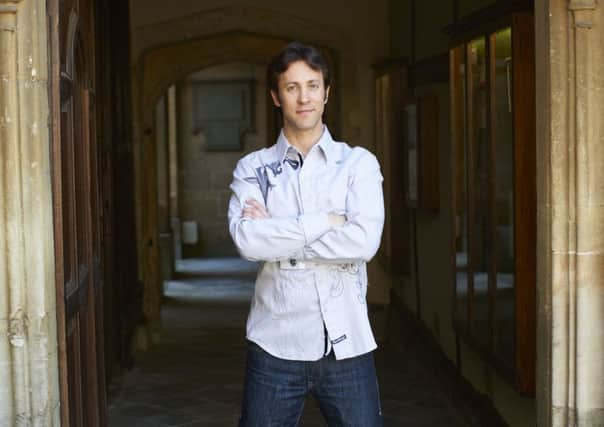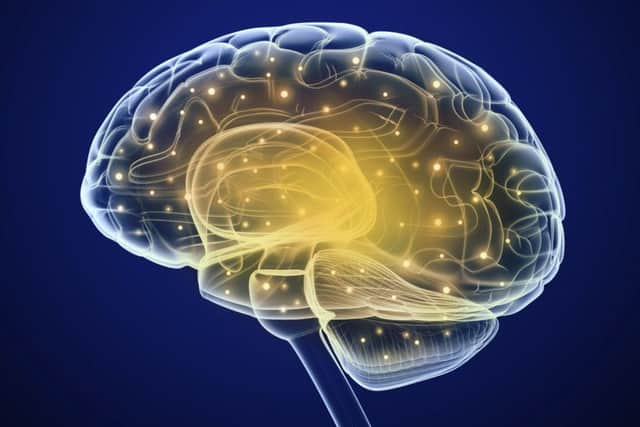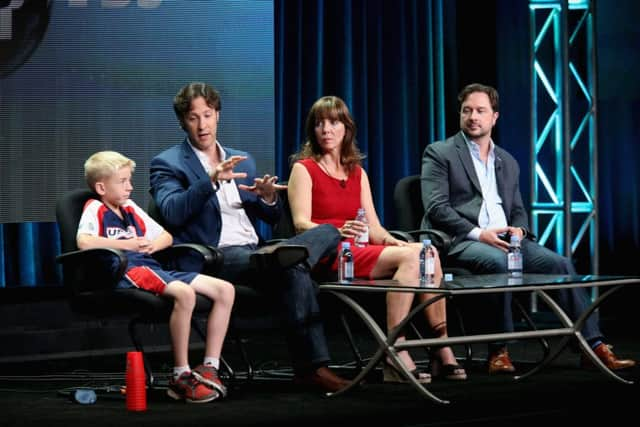Neuroscientist David Eagleman explains the brain


It weighs 3lbs. It takes 25 years to reach maturity and unlike any other part of our bodies if we damage it, even a tiny piece of it, it is likely to change who we are. The brain. That lump of stuff that sits between our ears, that makes us unique, that allows us to understand the world around us and each other. It’s no wonder reading David Eagleman’s new book, The Brain: The Story of You, made me a little bit giddy. Eagleman tosses about ideas that had my grey matter pushed and pummelled, stimulated and stretched. Reality is probably most accurately described as a “beautifully rendered simulation”, the unconscious has much more power over what we do than any of us are likely to be comfortable admitting, developments in sensory simulation mean the five senses we know about are only the beginning of how we might get information into our brains. Giddy, I tell you.
At the most basic level, Eagleman’s interest is the plasticity of our brains, the fact that they are ever-changing, which is what allows us to adapt. He draws comparisons with other mammals who are born with much more skill than humans – zebras who can run after only 45 minutes of life for example – but it is our “unfinished” state that is the marker of our potential. In Eagleman’s language, instead of being hardwired, we are “live-wired”. Our brains remain capable of change throughout our lives. Sure, once we are adults our brains are less adaptable, but still we retain the potential to adapt and learn. “I’ve grown very fond of saying it,” he says, “but it’s true, we’re not fixed; from cradle to grave we are works in progress. It’s so hard to think of ourselves that way because we are used to thinking I am so-so and this is who I am but that’s always a transient moment.”
Advertisement
Hide AdOnce described (by the New Yorker no less) as “the poster boy of science’s most fashionable field”, it’s not surprising that’s the kind of epithet that stuck. Eagleman is young and telegenic – just 41 – hugely smart with a kind of irresistible enthusiasm for his subject (his TED talks have been watched by millions) and a gift for making brain-bindingly complicated topics as clear as questions of consciousness and what constitutes reality are likely to get. He uses video games and physical challenges to illustrate how our brains work. He is best known for his work on time perception, synaesthesia and the application of neuroscience in criminal justice.


Eagleman’s mother was a biology teacher and his father a psychiatrist but that’s where the predictability of their son’s future in neuroscience ends. It was only when Eagleman was already in college (majoring in electrical engineering at Rice University in Houston, Texas) that he began to read about the brain and found himself “hooked”. He took a sabbatical, joined the Israeli army as a volunteer, spent a term at Oxford (political science and literature had attracted his interest by then) and then finally moved to LA to try his luck at becoming a stand-up comedian. When that didn’t work out, he went back to university to study neurolinguistics, bagged himself a PhD and then a job as a professor running a laboratory at Baylor College of Medicine. He’s written literary fiction as well as books about neuroscience. In terms of plasticity of brain, Eagleman is a walking, talking example of his own theory.
Throughout his book (which has the same name as the six-part series which has just started showing on PBS in the States) Eagleman reminds us that neuroscience is a young discipline, with all of its potential ahead. “We’re in this era where we have all this new technology which is providing a flood of data. That’s the good news,” he says. “The bad news is we, in many ways, are still missing the theoretical scaffolding on which to hang all of these details. There’s a sense in which some of the very basic problems – Why do brains sleep and dream? What is intelligence? How do you build consciousness? These are very basic questions and we still don’t know the answers to them. We have a long way to go. It’s sort of impossible to know looking forward but my impression is that we’re really just at the foot of the mountain.”
The questions that interest Eagleman are those which might more traditionally have been thought of as philosophical enquiries about reality and free will and consciousness. “There’s a sense in which the big questions – What is reality? Who am I? How do I make decisions? These are the sorts of questions that drew me into the field in the first place,” he says. “If you look at the overlap between the territories of neuroscience and philosophy there is a tremendous amount. There are many different ways to know and understand the world and I think neuroscience is a powerful inroad – it’s not the only one, when I advise people who want to become neuroscientists I advise them to take computer programming and philosophy as well as neuroscience. But at this point in history, you wouldn’t want to leave neuroscience off the palette of colours.” Neuroscience doesn’t yet have the experiments to rule out free will he writes, which of course, prompts the tantalising question will it one day?
“Prediction is a fool’s game,” he says, “but if the past is any indicator….” He leaves the possibility hanging. “One of my side quirky interests is finding old text books. I just obtained a chemistry text book from 130 years ago. It’s so unbelievability fascinating to look at what it’d be like to have the levels of knowledge that people had 130 years ago. You’d be doomed to come to all kinds of wrong conclusions because you just don’t know enough. And now that I’m thinking about it, I’m thinking that it’s a really good exercise that maybe all students should have to go through. Looking at old text books gives you a sense of the speed at which fields evolve and it’s not just an evolution of, ‘we measured a few things up at finer resolution’, instead it’s, ‘wow the whole theoretical scaffolding changed shape’.


“I can only imagine what neuroscience text books will look like in 140 years from now and the only thing I feel sure about is that they’ll be shorter. Principles of Neural Science, which is the standard text book, is well over 1,000 pages. If we really understood the principles it’d be more like a pamphlet, but we don’t.”
Advertisement
Hide AdIt makes me think about the kind of popular science books that Eagleman writes which crystallise complex ideas into something (relatively) easily digestible. “A good scientific theory compresses a lot of data,” he says. “That’s what we’re missing in neuroscience, we don’t yet have those big ideas that simplify things.”
Eagleman’s enthusiasm is part of what makes him such a brilliant communicator. He is absolutely fired up about these ideas and the potential of unlocking the mysteries of how our brains work. But he’s not only interested in the abstract, the purely theoretical, his passion is the intersection between neuroscience and understanding how we might use what it reveals to change how we do things. This might be developing robotic arms that can be controlled by amputees using only their minds, or neural implants that allow paralysed patients to regain movement. Eagleman’s lab has been working on a technology that can allow hearing-impaired people to hear, just not by using their ears. That’s the wonder of the brain, you see, it can receive information through any channel and it astonishingly has the capacity to make it intelligible. For Eagleman, bringing neuroscience into the social and political arenas and using it to come up with ideas about how penal systems work or the way that drug addicts might conquer their dependencies is the most exciting frontier of his work.
Advertisement
Hide Ad“To me that is where the rubber hits the road,” he says. “It’s where what we’re doing matters. Or at least it’s one of the places and it happens to be a big passion of mine.
“Social policy in the US has become really pathologic, the US has the highest incarceration rate of any country in the world. This doesn’t make any sense, it’s not cost effective and it’s very inhumane and so it seems to me looking at it through the lens of neuroscience there are a number of extremely obvious and fruitful things we can bring to bear on the problem. The response has been overwhelmingly positive because it’s one of the few issues politicians on both the left and the right agree upon – our incarceration rate is insane.”
The solutions, he says, are easy. Peel off special mental health courts from the main court system so that people with mental illness, who make up 30 per cent of the prison population in the US, are at least dealing with lawyers and judges who have expertise in that topic and know what is available in terms of rehabilitative strategies. And then the other thing that goes along with this is having specialised drug courts where you have people with similar awareness and expertise.
“Where this really comes into play is when it comes to juvenile justice,” he says, referring to the fact that neuroscience reveals that juvenile brains simply don’t function in the same way as those of adults. It’s during our teenage years that our brains get very busy with development of the self (and, of course) self-consciousness. Our medial prefrontal cortex – the bit of the brain that activates when we think about our self – peaks when we’re about 15 and then we get used to the idea and it settles and we become less self-conscious again. Similar changes happen in terms of risk. In neuroscientist speak, teenage brains have a mature pleasure-seeking system but an immature orbitofrontal cortex which gives them the heady combination of emotional hypersensitivity and less ability to control their emotions. “The pace of change has been slow but there are positive steps being taken in the US as a result of neuroscientists explaining what we know about this,” he says. “The Supreme Court has made several landmark decisions which are positive – no one can be sentenced to death for a crime committed when they were a juvenile. No one can be sentenced to life without parole for a crime committed when they were a juvenile.”
As our understanding of the brain grows exponentially, it is interesting to sit it alongside what we know about our rather fragile mental wellbeing. In many developed countries, rates of anxiety and depression are sky rocketing. One might look at the rate of prescribing of anti-depressants and suggest that our brains aren’t coping all that well in this brave new world. “The challenge is that we’ve got these brains which evolved in a very different period of time for a completely different world,” Eagleman says. “All of us in neuroscience have our opinions on this but fundamentally none of us knows where this is going. What happens when you expose brains to this kind of pace?”
Eagleman is, he says, a “cyber optimist” in many ways. Sitting in his car speaking to his wife on his bluetooth headset he glanced around and saw most people alone in the cars that surrounded him also talking on their phones. “Every single person was talking and they all looked basically happy and I thought I think there is less loneliness now because it’s so easy to connect with people. You don’t have to sit by yourself in an idling car and just wish that you were elsewhere, you can now be elsewhere with your friend. I have an incredibly positive view of this in that we’re incredibly social now and obviously there are pitfalls, the whole social media thing can become something of an obsession, but on the flip side – and I’d have to give more thought to this – I don’t know that there weren’t obsessions in yesteryear, social obsessions.”
Advertisement
Hide AdEagleman takes a similarly positive view when it comes to children and their engagement with technology. “I think kids of the next generation have got an opportunity to learn in ways that we simply did not. They’ll have adaptive educational software which will keep them right at their place of struggle which is exactly where you want to be, where things are frustrating but achievable. For kids with gumption who really want to learn about the world, this is an unbelievable time for them. The concern, of course, is that for kids who aren’t as organised or driven is that there are a million more distractions.”
Since Eagleman burst on to the scene with his mind-expanding ideas about neuroscience and his way of sharing them, he’s become a father. He has a three-year-old and a three-month old baby with his wife who is also a neuroscientist. I wonder what impact it’s had on him, watching these tiny brains developing in front of his eyes? “Oh god it’s changed me in every way,” he says. “Originally when I had kids someone said to me oh having kids is a whole new chapter, but I really feel that it’s more closing one book, going to the library and getting a whole new book.” He laughs. “It stretches you in so many different dimensions. On the one hand it really puts things like your patience to the test about what kind of person you want to be and what your buttons are that get pushed. And on the other hand it stretches you in terms of the depth of love you can feel. I didn’t even know I was capable of loving a little creature so much. Boy, it changes everything.”
Advertisement
Hide AdInterestingly, Eagleman says his work has freed him from some of the worries that plague parents about how their children will develop. For Eagleman the “detailed wiring” of the human brain isn’t pre-programmed, rather our genes give general directions for our neural development and our experience in the world fine tunes the rest. That’s why a loving, nurturing environment is “critical” for a child’s developing brain. But to imagine we can control it, is a fantasy.
“It kind of liberates me as a parent because in the end you feel like of course I’m going to do the best job that I can do, but there is no possibility given the size and complexity of my children’s experience that I can really steer that apart from in a very general way.”
Now that is a comforting thought.
• The Brain: The Story of You is published by Canongate. David Eagleman will be in conversation with Richard Holloway at the Royal Lyceum Theatre, Edinburgh on Monday, 2 November at 7:30pm. Tickets cost £12 (£10 concession). For more visit lyceum.org.uk/whats-on